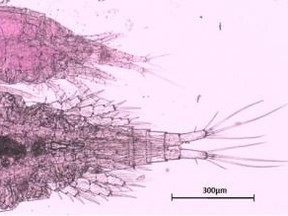Critter the first non-native species to enter Great Lakes in a decade

Article content
For the first time in a decade, a non-native aquatic species has been found in Lake Erie.
But if that brings to mind something like an insatiable Asian carp, think again.
Thermocyclops crassus, shown in the photo above, is a zooplankton, an invertebrate about the size of a pen tip. And it appears, so far, to have had little impact on its environment.
It was discovered in water drawn from an offshore sampling station just southwest of Kingsville.
Ordinarily, such samples contain as many as 800 microscopic creatures that all need to be counted, identified and catalogued. So finding one that doesn’t belong in lake water was beyond unexpected, said Joe Connolly, limnology technician at Cornell University, who discovered thermocyclops in samples from August 2014, ’15 and ’16.
“It’s kind of like looking for a needle in a haystack,” Connolly said. “I didn’t know what it was, but I knew it wasn’t something we’d seen before.”
The last non-native species found in the Great Lakes was the bloody red shrimp, a fingernail-sized crustacean that now travels in swarms in the lakes. The identification was confirmed by a scientist from the Smithsonian Institution.
Connolly found male and female thermocyclops in low numbers but enough to say there’s an established population.
They’re native to warm freshwater areas of Europe, Asia and Australia, Connolly said.
Officials from Environment Canada and the U.S. Environmental Protection Agency will do more sampling to determine how widespread thermocyclops are and what impact they may have.
Over the years, 185 aquatic non-native species have become established in the Great Lakes basin.
Asian carp, the hungry monster fish that have invaded some U.S. lakes and rivers and are pegged as one of the next big threats to Great Lakes basin, have been found sporadically in Lake Erie, but not in breeding populations.
As for thermocyclops, “We don’t know enough yet about what this species could or could not do in the Great Lakes,” said Elizabeth Hinchey Malloy, an environmental scientist with the U.S. EPA.
This population was found on the Canadian side of Erie as Cornell University’s biological field study lab analyzed samples from dozens of sites in the lakes.
It’s not the first time it’s been detected in North America. One was identified in 1991 in Lake Champlain but not found there again, and another was noticed in the sediment of a ballast-water tank on a trans-oceanic ship in 2001-02 before strict ballast water flushing standards took effect.
It’s expected these thermocyclops also arrived in ballast water, Hinchey Malloy said.
Nutrient-rich Erie is the warmest Great Lake, which may make it a more suitable incubator. Part of thermocyclops’ diet is blue-green algae — huge blankets of which have covered western Lake Erie during warm summer months — but it doesn’t consume enough to make a dent in that problem, both Connolly and Hinchey Malloy said.
It’s too soon to say if thermocyclops crassus is invasive, meaning it introduces harm into the environment or economy.